

Strategies for Effective Classroom Management
Effective classroom management is very important for creating a positive learning environment. By using proven strategies, teachers can easily foster student engagement, reduce disruptions, and improve overall learning. In this blog, we will explore ten strategies that can significantly enhance classroom management. These strategies not only help maintain order but also encourage students to participate actively in their education. As we go through each strategy, it will become clear how they can work together to create a better classroom experience for everyone.
1. Establish Clear Rules and Expectations
Establishing clear rules and expectations right from the start of the school year is very important. You see, when students are aware of what is expected of them, they will be more likely to follow those guidelines. Additionally, teachers should work together with students to create these rules. This will help foster a sense of ownership among the students. Furthermore, this involvement will encourage students to take responsibility for their actions. As a result, it will contribute to a positive classroom culture overall.

2. Build Positive Relationships
Building positive relationships with students is foundational for effective classroom management. When teachers show genuine interest in their students’ lives, it fosters trust and respect. This connection can lead to better cooperation and a more harmonious classroom environment. Teachers can take time to learn about their students’ interests and backgrounds, which can enhance engagement and reduce behavioral issues.
3. Use Positive Reinforcement
Positive reinforcement is a very effective tool for encouraging good behaviors in students. When students are recognized for their good behavior or academic achievements, they are much more likely to repeat those positive actions. For example, teachers can use a reward system that includes praise, stickers, or extra privileges to motivate their students. Moreover, this approach not only boosts student morale but also helps create a supportive atmosphere that is conducive to learning. As a result, students feel valued and motivated to do their best in class.
4. Implement Consistent Consequences
Consistency in enforcing consequences for misbehavior is very important. First, teachers should establish clear consequences for breaking the rules and apply them fairly to all students. This consistency helps students understand the boundaries and why it is important to follow them. Additionally, when students see that rules are enforced in the same way for everyone, they are much more likely to respect those rules. Furthermore, this fair approach creates a sense of trust and helps build a positive classroom environment. Overall, consistency is key to effective classroom management.
If you are a teacher and searching for the best teaching courses, you are on the right platform. Visit our website and read our blog for more details.
5. Incorporate Interactive Teaching Techniques
Using interactive teaching techniques is a great way to engage students and reduce disruptions in the classroom. For example, group discussions, hands-on activities, and technology integration can make lessons much more dynamic and interesting. When students are actively involved in their learning, they are less likely to become distracted or misbehave. Additionally, teachers should strive to vary their teaching methods to meet the needs of different learning styles. By doing this, teachers can create a more inclusive environment where all students feel engaged and motivated to learn. Overall, incorporating interactive techniques can lead to a more effective classroom experience.
6. Create a Structured Environment
A well-organized classroom plays a big role in effective management. First, teachers should arrange the physical space to make learning easier and to minimize distractions. For example, desks can be arranged in a way that encourages collaboration while keeping noise levels low. Additionally, establishing routines for daily activities helps students know what to expect, which can reduce anxiety and behavioral issues. When students understand the daily schedule, they feel more secure and focused. Furthermore, a structured environment promotes focus and productivity, allowing students to concentrate better on their work. Overall, organization is key to creating a successful classroom.
7. Foster Student Autonomy
Encouraging student autonomy is a fantastic way to increase engagement and responsibility. For example, teachers can allow students to choose their assignments or let them lead class discussions. This approach makes students feel important and involved in their learning. When students have a say in what they do, they are more likely to take charge of their actions. Also, this method promotes independence and helps develop critical thinking skills. Moreover, students who feel empowered are often more motivated to succeed. In short, encouraging student autonomy creates a classroom where students are engaged and take responsibility for their learning.
8. Utilize Non-Verbal Cues
Non-verbal cues are a great way to manage classroom behavior without interrupting lessons. For example, simple gestures like hand signals or eye contact can redirect students’ attention or signal that something needs to change. This technique is helpful because it lets teachers keep the lesson going while addressing behavior issues. Also, using non-verbal cues helps create a more focused learning environment, keeping students engaged. Plus, this method reduces disruptions, making it easier for everyone to learn. In short, non-verbal cues are a simple yet powerful way to manage behavior in the classroom.
9. Communicate with Parents
Establishing open communication with parents is very important for effective classroom management. For example, providing regular updates about student progress and behavior can help foster a partnership that supports learning. When parents are involved, they can reinforce positive behaviors at home. This creates a consistent approach to discipline and support. Additionally, open communication helps build trust between teachers and parents. Furthermore, when parents feel informed and involved, they are more likely to support the teacher’s efforts in the classroom. Overall, maintaining open lines of communication with parents is key to creating a successful learning environment for students.
10. Reflect and Adapt
Finally, reflecting on classroom management practices is crucial for ongoing improvement. Teachers should regularly think about which strategies are effective and which ones might need changes. Asking students for feedback can give important insights into their experiences. This reflective practice helps teachers adjust their methods to better meet the changing needs of their students.
Moreover, You can get more details by visiting our website, The Business Cluster.
Conclusion
In conclusion, effective classroom management is a complex task that requires commitment and flexibility. By using these ten strategies, teachers can build a positive and engaging learning environment. It’s important to remember that the goal isn’t just to keep order but to create a space where every student feels important and eager to learn.
As you think about these strategies, consider how you can apply them in your own classroom. Even small changes can make a big difference in how your classroom runs. If you found this information useful, think about joining our community for more tips and support in your teaching journey. Together, we can create classrooms where every student succeeds!
Barkha Sachdeva is a B.Com(Hons) graduate from Delhi University. Passionate about crafting content, she enjoys writing about fashion, beauty, technology, and travel. With three years of content writing experience, she possesses valuable insights and ideas in these domains.







Post Comment